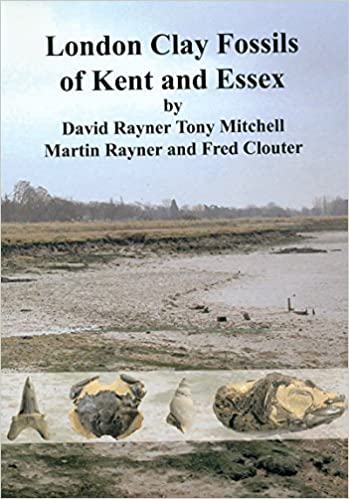London Clay Fossils of Kent and Essex
By David Rayner, Tony Mitchell, Martin Rayner and Fred Clouter

The very small number of books published by the Medway Fossil and Mineral Society are without exception, wonderful and this is probably the best (see also Ammonites & Other Cephalopods of the Lower Cretaceous Albian (Gault Clay and Folkestone Beds) of the South East of England – less than a snappy title, great book).
And, there are very few guides on the London Clay, an Eocene deposit representing a warmer, more tropical era of the UK. The Palaeontological Society has published the book, Fossil Plants of the London Clay, Field Guide to Fossils No 1, by Margaret E Collinson, but this obviously does not cover fauna. Similarly, the Geologists’ Association published A Pocket Guide to the London Clay Exposed on the North Shore of the Isle of Sheppey, Kent, but this is a Rockwatch Guide intended for children and young teenagers. (Rockwatch is the national geology club for young people, which forms the junior club of the Geologists’ Association.) It does not publish a guide to any of relevant areas. Therefore, London Clay Fossils of Kent and Essex is invaluable and more than welcome.
This A4-sized, full colour guide builds on the success of the society’s previous black and white guide, London Clay Fossils of the Isle of Sheppey. However, the newer guide is expanded to include several new groups, including seeds and fruits, and also fossils from the London Clay of the rest of Kent and Essex.
In that respect, details of some the important and available London Clay sites are given, along with access maps, collecting hints and lists of species. In fact, one point that becomes clear when reading the book is that that there is considerable difference between the species found in the London and Hampshire Basins, and from site to site.
The collecting sites covered are:
- Essex: Walton-on-the Naze.
- Essex: Maylandsea.
- Essex: Butts Cliff near Burnham-on-Crouch.
- Essex: The Isle of Sheppey, Minster to Warden Point.
- Kent: Seasalter.
- Kent: Tankerton.
- Other collecting points, including Steeple Bay (Essex), Aveley (Essex), Lower Upnor (Kent), Allhollows (Kent), Elmley Hill (Kent), Hampton Pier/Stidd Hill (Kent), Herne Bay/East Cliff to Beltinge (Kent), and a site on the Medway Estuary (Kent).
In the identification section, the technical words tend to be kept to a minimum. This is because the guide only covers species from a relatively limited geological period and habitat zone. Therefore, it is not necessary, for example, to distinguish a crab from all other crabs, but only from those crabs found in the London Clay of Kent and Essex. To this end, the authors seem to have illustrated as many species as possible, while pointing out in the text and annotated photographs those features that are valuable in distinguishing one London Clay fossil from another.
In terms of the flora and fauna, the chapters cover:
- Formanifera.
- Bryozoa.
- Worms, trace fossils and corals.
- Lobsters, stomatopods and crabs
- Brachiopods and gastropods.
- Nautili and coleoides.
- Crinoids.
- Echinoids and starfish.
- Sharks, rays and chimaera.
- Bony fish.
- Otoliths.
- Turtles, snakes and crocodiles.
- Birds.
- Mammals.
- Plants.
So this is a great guide to get if you want to explore the London Clay. But I would say that, as Fred Clouter signed my copy after a great trip with him to the Isle of Sheppey during which I found a lobster (Hoploparia gammaroides)!
London Clay Fossils of Kent and Essex, by David Rayner, Tony Mitchell, Martin Rayner and Fred Clouter, Medway Fossil and Mineral Society, Rochester, Kent (2009) 228 pages (paperback), ISBN: 978-0-9538243-1-1.